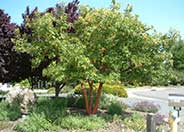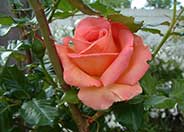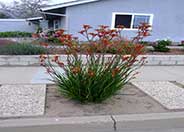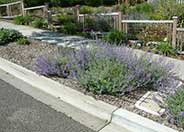
Common name:Small Cape Rush
Botanical name:Chondropetalum tectorum
Chondropetalum tectorum has 3'-4' tall stems that shoot out in all directions from the roots. Each stem has papery bracts connected to the ends that turn from tan to dark drown, then fall off. Chondropetalum can grow in marshes, in the ground with regular watering, or in drought conditions.

Common name:Strawberry Madrone
Botanical name:Arbutus 'Marina'
The 'Marina' has gorgeous bark, with leaves that are smaller and not as glossy as Pacific Madrone. Its flowers are pink, borne in pendant clusters in the summer. The fruit is large, red and quite ornamental. The plant should be grown in sun to part shade, with little or no summer watering when established. The 'Marina' prefers good drainage. -Monterey Bay Nursery

Common name:Hybrid Tea Rose (selections)
Botanical name:Rosa Hybrid Tea varieties
These shrubs and vines are the most loved in the Western USA and are very resilient. They come in a wide variety of sizes and colors and are easy to maintain with proper care. They can be used in a water-conserving garden with careful attention to irrigation practices.

Common name:Red Cross Kangaroo Paws
Botanical name:Anigozanthos 'Red Cross'
Red Cross Kangaroo Paws has showy, tall (4'-5'), multi- branched stems with rich red color on both flowers and stems. The flowers have a green interior. It is fast growing.

Common name:Catmint
Botanical name:Nepeta X faassenii
Nepeta faassenii makes soft, gray green, undulating mounds that are 1.5' high when blooming. The small leaves are attractive to cats. This perennial has lavender blue flowers in late spring and early summer.

Common name:Autumn Sage
Botanical name:Salvia greggii 'Alba'
This drought-tolerant, evergreen shrub is 4' tall x 4' wide and produces beautiful white flowers that bloom from spring to fall.
Designer: Barbara Jackel Landscape Dsgn
Photographer: GardenSoft
Maintain a two to four inch layer of mulch on the soil surface to reduce weeds, infiltrate rain water, and reduce compaction.
Check the soil's moisture level before watering.
You can reduce your water use 20-50% by regularly checking the soil before watering.
Develop healthy soil for plants that are vigorous and naturally pest-resistant.